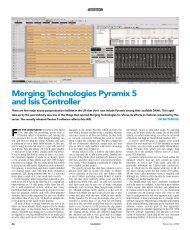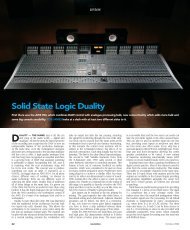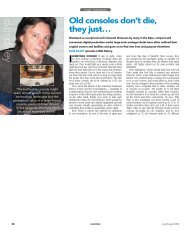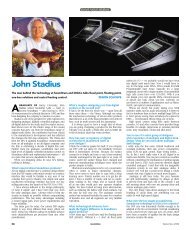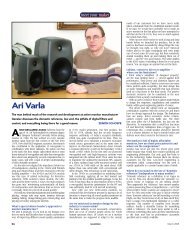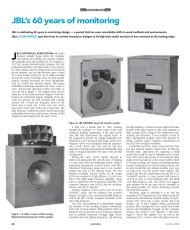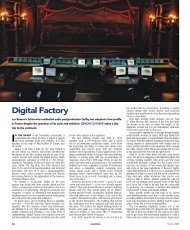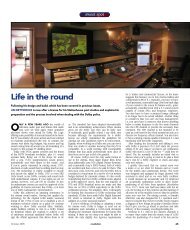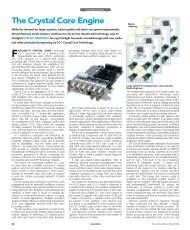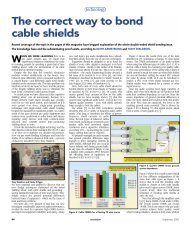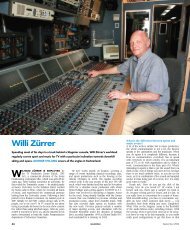Christopher Hicks â CEDAR Audio - Resolution
Christopher Hicks â CEDAR Audio - Resolution
Christopher Hicks â CEDAR Audio - Resolution
Create successful ePaper yourself
Turn your PDF publications into a flip-book with our unique Google optimized e-Paper software.
meet your maker<br />
<strong>Christopher</strong> <strong>Hicks</strong><br />
<strong>CEDAR</strong> <strong>Audio</strong>’s senior engineer talks about the technology behind the company’s<br />
products, the algorithm refinement process, processing power hikes, and why he<br />
likes tea without sugar.<br />
CHRISTOPHER HICKS HAS been associated<br />
with <strong>CEDAR</strong> since 1992 and has worked fulltime<br />
there since 1996. Prior to this he was at<br />
Cambridge University doing a BA and then a PhD in the<br />
Engineering Department and maintains his Cambridge<br />
University connection by teaching mathematics and<br />
electronics to engineering undergraduates at Churchill<br />
College for a few hours a week. As a senior engineer<br />
at the company his main responsibility has been the<br />
hardware products — the Series X and X+ rackmount<br />
units, the DNS1000, DNS2000, the Duo declickle and<br />
autodehiss boxes, and also the timecode unit that<br />
forms part of <strong>CEDAR</strong> Cambridge.<br />
He was a committee member of the British AES<br />
section for many years, and was its chair for 1999-<br />
2000. Together with <strong>CEDAR</strong>’s Dave Betts he received<br />
a Technical Achievement Award from the Academy<br />
of Motion Picture Arts and Sciences in 2005 for their<br />
co-design of the DNS1000.<br />
In his spare time he sings with a local chamber<br />
choir, admits to playing the violin badly as well as<br />
doing a fair amount of classical music recording<br />
— ‘it’s nice to use the kit once in a while, not just<br />
design it!’ he says.<br />
ZENON SCHOEPE<br />
What is special about <strong>CEDAR</strong> products?<br />
I hope that many things make them special, but I will<br />
concentrate on just one. At <strong>CEDAR</strong> we have, from<br />
the outset, been faced with the problem of making<br />
cutting-edge digital signal processing technology<br />
accessible to people who are not experts in DSP.<br />
This has implications both for how the algorithms<br />
are designed, and for how they are embodied as<br />
products. For example, on reading the academic<br />
literature one soon discovers that ‘robust’ algorithms<br />
are considered a good thing. This really means that<br />
the same algorithm will work well in a wide range of<br />
circumstances, is not particularly sensitive to changes<br />
in the audio, and does not require frequent parameter<br />
adjustments.<br />
The practical upshot of robustness is that the<br />
exact setting of each control is not particularly<br />
critical and sometimes, as an algorithm is refined,<br />
it becomes possible to remove a control that one<br />
previously thought was needed. So, by designing<br />
our algorithms to be robust, our products become<br />
quick and straightforward to use, despite containing<br />
complex DSP.<br />
From the days of the original DC1 declicker, which<br />
we released in 1992, it was a standing joke within<br />
<strong>CEDAR</strong> that the default settings (Medium 10) would<br />
work for all but the most demanding applications of<br />
the product.<br />
How do years of producing algorithms manifest<br />
themselves in your products — are we still<br />
listening to the same original declick algorithm?<br />
Absolutely not. The research that grew into <strong>CEDAR</strong><br />
occurred in the late 1980s. It used FORTRAN code,<br />
running on 80286-based PCs, and would take several<br />
hours to process a single side of a 78 — the principal<br />
focus of that initial research. Since then we have gone<br />
through several generations of DSP chips, several<br />
programming languages, and several generations of<br />
PCs and the like, so <strong>CEDAR</strong> has been implemented on<br />
numerous different platforms.<br />
The easy way to revise a product for a new<br />
platform is to re-code existing algorithms and move<br />
on. At <strong>CEDAR</strong>, however, we have used each of<br />
these occasions as an opportunity to re-examine<br />
the algorithms and refine them. Furthermore,<br />
each platform generally represents an increase in<br />
computational power over the previous one, and this<br />
can allow us to extend the sophistication of algorithms<br />
we had previously been forced to simplify for lack of<br />
memory or processor speed.<br />
What are the common technical approaches<br />
involved when designing restoration algorithms<br />
and at what point do they start to differ?<br />
Engineering is all about analysing problems, and<br />
solving them through innovation. A key component<br />
of that process is scientific method, where progress<br />
is based upon evidence gleaned from experiment.<br />
However, engineering is differentiated from pure<br />
science by the existence of the customer. A perfect<br />
technical solution to a problem is unacceptable if it is<br />
impossible or impractical for the customer to adopt it,<br />
perhaps because of the final cost or the nature of the<br />
product that would result.<br />
Furthermore, defining the problem can be a<br />
challenge in itself. Faced with a customer who says,<br />
‘I have an analogue thingy, but my studio is going<br />
all-digital, so can you make me a digital thingy?’ one<br />
could, of course, comply by creating a digital thingy.<br />
A deeper approach, and one that we regularly adopt,<br />
is to identify the problem the analogue thingy is being<br />
used to solve, and then to develop a solution to that<br />
problem; a solution that also happens to be digital.<br />
This occurred in the early stages of the DNS1000<br />
project, which was triggered by a request to produce<br />
a digital version of an existing piece of analogue<br />
equipment. By adopting the deeper design process,<br />
we improved substantially on the performance of the<br />
‘analogue thingy’ and the DNS1000 consequently<br />
had much broader appeal than it otherwise would<br />
have had.<br />
Which restoration algorithm is the most<br />
difficult for you to implement?<br />
Broadband hiss removal. Let me explain.<br />
I like my tea without sugar. Declicking is a bit<br />
like trying to fish the fragments of a badly-dunked<br />
Rich Tea biscuit out of a cup of sugary PG Tips; the<br />
individual bits remain reasonably intact, so if you’re<br />
quick and careful you can get most of them out and<br />
the tea remains drinkable. Removing hiss is like trying<br />
to get the sugar out; a chemist could possibly devise<br />
a sequence of chemical reactions with nasty reagents<br />
that would do it, but would you want to drink the<br />
result? The cure may be worse than the problem. Now<br />
to get back to signal processing...<br />
It is a well-established tenet of Information Theory<br />
that information is lost when two random signals (for<br />
example, music and noise) are mixed together. It is<br />
therefore impossible to separate them perfectly, so<br />
‘perfect’ dehissing is not possible. (Nor, as it happens,<br />
is it necessarily desirable, but that leads us into a<br />
discussion about psychoacoustics, which is probably<br />
inappropriate here.)<br />
To make a useful attempt at separating the wanted<br />
48 resolution April 2006
meet your maker<br />
signal and the noise, we rely on at least one of the<br />
signals having some inherent degree of predictability.<br />
This predictability might be embodied in a ‘fingerprint’<br />
of the noise alone, or a statistical description of the<br />
wanted signal based on some assumption such as<br />
‘music is composed of a multitude of sinewaves’.<br />
Any deviation of the actual signal and/or noise from<br />
the chosen model (which there will inevitably be, the<br />
signal and noise both being random) could reveal<br />
itself as an undesirable artefact in the processed<br />
result. Choosing the models and refining them such<br />
that the artefacts are minimised is the complicated<br />
(and interesting) bit; finding a chemical reaction that<br />
removes the sugar without ruining the tea!<br />
How reliant is the development of your<br />
restoration products on progress in<br />
processing power?<br />
For technological reasons, <strong>CEDAR</strong> was later than<br />
many other audio equipment manufacturers to<br />
support the 88.2kHz and 96kHz sample rates.<br />
When you double the sample rate, simple algorithms<br />
such as EQ, mixing, and compression require<br />
approximately double the memory and double the<br />
processor power. In contrast, many of <strong>CEDAR</strong>’s<br />
algorithms require up to about four times the<br />
processor speed to support a doubling of sample<br />
rate. We therefore had to wait longer before we<br />
could support these higher sample rates.<br />
Having said that, it has only been 20 years since the<br />
aforementioned FORTRAN code was written, and it is<br />
remarkable to think that my laptop PC could process that<br />
78 to a much higher standard in a matter of seconds!<br />
Where are the limitations and bottlenecks<br />
in the technology you currently use<br />
and what advances will herald the<br />
next step up?<br />
Humans (particularly males, I am told!) are poor at<br />
thinking about more than one thing at a time. One<br />
consequence of this is that we naturally break down<br />
solutions to problems into sequences of steps, one to<br />
be executed after the other. In the computer world,<br />
multiprocessor and multicore machines are rapidly<br />
becoming the norm, and to utilise these effectively<br />
requires a different approach in which we think about<br />
which steps can be executed in parallel with, and<br />
independently from, each other.<br />
If these independent processes are working<br />
towards a common<br />
goal they will have to communicate<br />
and synchronise with each other at certain points.<br />
This creates another set of problems, exemplified<br />
by the deadlock; four cars arrive at a miniroundabout<br />
simultaneously, and everybody waits<br />
for everybody else.<br />
The situation is exacerbated when one tries to make<br />
a real-time audio application co-exist with a generalpurpose<br />
operating system and other software. If the<br />
operating systems in general use had been designed<br />
from the ground up with real-time applications in<br />
mind, it would make life a whole lot easier for realtime<br />
software developers. As it is, we all have to go<br />
to extreme lengths to ensure that interruptions to the<br />
audio stream do not occur.<br />
The DNS1000 has achieved incredible<br />
success in post yet it is unusual in your<br />
product range as a standalone product type.<br />
Can we expect to see similar ‘console-top’<br />
type processors?<br />
The reason that the DNS1000 is console-style has<br />
nothing to do with the requirements of the signal<br />
processing, and everything to do with the way our<br />
customers want to use it. The point is that each of<br />
our hardware products is a complete design, and not<br />
just an algorithm in a box; we take a great deal of<br />
account of the environment our customers will be<br />
working in, and how our products will best fit into<br />
their workflow.<br />
The main market for the DNS1000 is in<br />
postproduction, where time is always of the essence. A<br />
principal requirement, therefore,<br />
was a simple, uncluttered control surface that<br />
could be operated quickly with one hand in neardarkness.<br />
The console-style with big buttons and<br />
faders fits that requirement well. We have other<br />
hardware products that are based more upon a ‘setand-forget’<br />
approach, and a rackmount format suits<br />
those better.<br />
Why did you release <strong>CEDAR</strong> for Pro Tools on<br />
PC rather than on Mac?<br />
At the moment, the PC environment has proved to be<br />
better for hosting and supporting <strong>CEDAR</strong>’s algorithms<br />
and products. For the future, we are keeping a close<br />
eye on the rapid changes occurring in Apple’s product<br />
lines and operating systems, although I would be<br />
loath to speculate where these might lead us.<br />
How long-term is the business of<br />
restoration?<br />
The supply of vintage recordings needing restoration<br />
is large, but finite, so I suppose an end to that business<br />
is inevitable, if a long way off. However, modern<br />
recordings also suffer from similar problems; electrical<br />
interference, equipment malfunction, operator error<br />
and other ‘technical hitches’ cause all manner of<br />
unwanted noises and distortions, quite apart from the<br />
background noise that is inevitable on location and<br />
in environments such as concert halls. Consequently,<br />
the need for audio restoration will never dry up; quite<br />
the opposite in fact, as increasing amounts of material<br />
are recorded and broadcast under greater pressure and<br />
on shrinking budgets.<br />
And then there’s the matter of forensic audio<br />
investigation… but that’s a story for another day. ■<br />
April 2006<br />
resolution<br />
49





